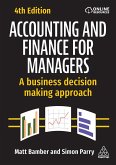- Gebundenes Buch
- Merkliste
- Auf die Merkliste
- Bewerten Bewerten
- Teilen
- Produkt teilen
- Produkterinnerung
- Produkterinnerung
Dedicated to answering the question: Why Cost Management? this book provides the cost-management tools and techniques needed to support an organisation's competitiveness, improve its performance, and help the organisation accomplish its strategy. It helps students understand the broader role of cost accounting in helping an organisation succeed.
Andere Kunden interessierten sich auch für
![Finance for Non-Finance People Finance for Non-Finance People]() Sandeep GoelFinance for Non-Finance People43,99 €
Sandeep GoelFinance for Non-Finance People43,99 €![Financial Intelligence for It Professionals Financial Intelligence for It Professionals]() Julie BonnerFinancial Intelligence for It Professionals147,99 €
Julie BonnerFinancial Intelligence for It Professionals147,99 €![The Economics of Central Banking The Economics of Central Banking]() Livio StraccaThe Economics of Central Banking63,99 €
Livio StraccaThe Economics of Central Banking63,99 €![Financial Intelligence for IT Professionals Financial Intelligence for IT Professionals]() Julie BonnerFinancial Intelligence for IT Professionals39,99 €
Julie BonnerFinancial Intelligence for IT Professionals39,99 €![Statutory Audits in Europe Statutory Audits in Europe]() Michael KendStatutory Audits in Europe183,99 €
Michael KendStatutory Audits in Europe183,99 €![Accounting and Finance for Managers Accounting and Finance for Managers]() Matt BamberAccounting and Finance for Managers61,99 €
Matt BamberAccounting and Finance for Managers61,99 €![Accounting and Finance for Managers Accounting and Finance for Managers]() Matt BamberAccounting and Finance for Managers199,99 €
Matt BamberAccounting and Finance for Managers199,99 €-
-
-
Dedicated to answering the question: Why Cost Management? this book provides the cost-management tools and techniques needed to support an organisation's competitiveness, improve its performance, and help the organisation accomplish its strategy. It helps students understand the broader role of cost accounting in helping an organisation succeed.
Hinweis: Dieser Artikel kann nur an eine deutsche Lieferadresse ausgeliefert werden.
Hinweis: Dieser Artikel kann nur an eine deutsche Lieferadresse ausgeliefert werden.
Produktdetails
- Produktdetails
- Verlag: McGraw-Hill Education - Europe
- 7 ed
- Seitenzahl: 928
- Erscheinungstermin: 26. August 2015
- Englisch
- Abmessung: 282mm x 222mm x 35mm
- Gewicht: 1942g
- ISBN-13: 9780077733773
- ISBN-10: 0077733770
- Artikelnr.: 43171609
- Herstellerkennzeichnung
- Libri GmbH
- Europaallee 1
- 36244 Bad Hersfeld
- gpsr@libri.de
- Verlag: McGraw-Hill Education - Europe
- 7 ed
- Seitenzahl: 928
- Erscheinungstermin: 26. August 2015
- Englisch
- Abmessung: 282mm x 222mm x 35mm
- Gewicht: 1942g
- ISBN-13: 9780077733773
- ISBN-10: 0077733770
- Artikelnr.: 43171609
- Herstellerkennzeichnung
- Libri GmbH
- Europaallee 1
- 36244 Bad Hersfeld
- gpsr@libri.de
Edward J. Blocher is an emeritus professor of accounting at the Kenan-Flagler Business School at the University of North Carolina at Chapel Hill. His undergraduate degree (economics) is from Rice University, his MBA from Tulane University, and his Ph.D. from the University of Texas at Austin. Professor Blocher has presented regularly on strategic cost management at the national meetings of both the American Accounting Association (AAA) and the Institute of Management Accountants (IMA). While he is involved in a number of accounting organizations, Professor Blocher has been most continually active in the IMA, where he has been a member of the IMAs Research Foundation. He is a certified management accountant (CMA), has taught review courses for the CMA exam, and has served on the IMAs national education committee. He has supervised or participated in the direction of several doctoral students, many of whom prepared dissertations in management accounting. Professor Blocher is also the author or co-author of several articles in management accounting and in other areas of accounting and has served as associate editor and reviewer for a number of accounting journals. He has a 2009 article in Issues in Accounting Education on the topic of teaching strategic cost management. Putting research and teaching into practice is important to Professor Blocher, who has worked closely with other firms and organizations in developing products, publications, and teaching materials. He was a member of the task force for the IMA that developed a new definition of management accounting in 2008. From 20102014, he served as a member of the joint curriculum task force of the Management Accounting Section (MAS) of the AAA and the IMA, which was charged with the responsibility of developing curriculum recommendations for accounting education. The task force has two recent publications in Issues in Accounting Education. Also, he has provided expert testimony and has consulted with a number of organizations regarding cost management matters.
PART ONEINTRODUCTION TO STRATEGY, COST MANAGEMENT, AND COST SYSTEMS
Chapter 1 Cost Management and Strategy
Chapter 2 Implementing Strategy: The Value Chain, the Balanced Scorecard,
and the Strategy Map
Chapter 3 Basic Cost Management Concepts
Chapter 4 Job Costing
Chapter 5 Activity-Based Costing and Customer Profitability Analysis
Chapter 6 Process Costing
Chapter 7 Cost Allocation: Departments, Joint Products, and By-Products
PART TWOPLANNING AND DECISION MAKING
Chapter 8 Cost Estimation
Chapter 9 Short-Term Profit Planning: Cost-Volume-Profit (CVP) Analysis
Chapter 10 Strategy and the Master Budget
Chapter 11 Decision Making with a Strategic Emphasis
Chapter 12 Strategy and the Analysis of Capital Investments
Chapter 13 Cost Planning for the Product Life Cycle: Target Costing, Theory
of Constraints, and Strategic Pricing
PART THREEOPERATIONAL-LEVEL CONTROL
Chapter 14 Operational Performance Measurement: Sales, Direct-Cost
Variances, and the Roleof Nonfinancial Performance Measures
Chapter 15 Operational Performance Measurement: Indirect-Cost Variances and
Resource-Capacity Management
Chapter 16 Operational Performance Measurement: Further Analysis of
Productivity and Sales
Chapter 17 The Management and Control of Quality
PART FOURMANAGEMENT-LEVEL CONTROL
Chapter 18 Strategic Performance Measurement: Cost Centers, Profit Centers,
and the Balanced Scorecard
Chapter 19 Strategic Performance Measurement: Investment Centers
Chapter 20 Management Compensation, Business Analysis, and Business
Valuation
GLOSSARY
INDEX
Chapter 1 Cost Management and Strategy
Chapter 2 Implementing Strategy: The Value Chain, the Balanced Scorecard,
and the Strategy Map
Chapter 3 Basic Cost Management Concepts
Chapter 4 Job Costing
Chapter 5 Activity-Based Costing and Customer Profitability Analysis
Chapter 6 Process Costing
Chapter 7 Cost Allocation: Departments, Joint Products, and By-Products
PART TWOPLANNING AND DECISION MAKING
Chapter 8 Cost Estimation
Chapter 9 Short-Term Profit Planning: Cost-Volume-Profit (CVP) Analysis
Chapter 10 Strategy and the Master Budget
Chapter 11 Decision Making with a Strategic Emphasis
Chapter 12 Strategy and the Analysis of Capital Investments
Chapter 13 Cost Planning for the Product Life Cycle: Target Costing, Theory
of Constraints, and Strategic Pricing
PART THREEOPERATIONAL-LEVEL CONTROL
Chapter 14 Operational Performance Measurement: Sales, Direct-Cost
Variances, and the Roleof Nonfinancial Performance Measures
Chapter 15 Operational Performance Measurement: Indirect-Cost Variances and
Resource-Capacity Management
Chapter 16 Operational Performance Measurement: Further Analysis of
Productivity and Sales
Chapter 17 The Management and Control of Quality
PART FOURMANAGEMENT-LEVEL CONTROL
Chapter 18 Strategic Performance Measurement: Cost Centers, Profit Centers,
and the Balanced Scorecard
Chapter 19 Strategic Performance Measurement: Investment Centers
Chapter 20 Management Compensation, Business Analysis, and Business
Valuation
GLOSSARY
INDEX
PART ONEINTRODUCTION TO STRATEGY, COST MANAGEMENT, AND COST SYSTEMS
Chapter 1 Cost Management and Strategy
Chapter 2 Implementing Strategy: The Value Chain, the Balanced Scorecard,
and the Strategy Map
Chapter 3 Basic Cost Management Concepts
Chapter 4 Job Costing
Chapter 5 Activity-Based Costing and Customer Profitability Analysis
Chapter 6 Process Costing
Chapter 7 Cost Allocation: Departments, Joint Products, and By-Products
PART TWOPLANNING AND DECISION MAKING
Chapter 8 Cost Estimation
Chapter 9 Short-Term Profit Planning: Cost-Volume-Profit (CVP) Analysis
Chapter 10 Strategy and the Master Budget
Chapter 11 Decision Making with a Strategic Emphasis
Chapter 12 Strategy and the Analysis of Capital Investments
Chapter 13 Cost Planning for the Product Life Cycle: Target Costing, Theory
of Constraints, and Strategic Pricing
PART THREEOPERATIONAL-LEVEL CONTROL
Chapter 14 Operational Performance Measurement: Sales, Direct-Cost
Variances, and the Roleof Nonfinancial Performance Measures
Chapter 15 Operational Performance Measurement: Indirect-Cost Variances and
Resource-Capacity Management
Chapter 16 Operational Performance Measurement: Further Analysis of
Productivity and Sales
Chapter 17 The Management and Control of Quality
PART FOURMANAGEMENT-LEVEL CONTROL
Chapter 18 Strategic Performance Measurement: Cost Centers, Profit Centers,
and the Balanced Scorecard
Chapter 19 Strategic Performance Measurement: Investment Centers
Chapter 20 Management Compensation, Business Analysis, and Business
Valuation
GLOSSARY
INDEX
Chapter 1 Cost Management and Strategy
Chapter 2 Implementing Strategy: The Value Chain, the Balanced Scorecard,
and the Strategy Map
Chapter 3 Basic Cost Management Concepts
Chapter 4 Job Costing
Chapter 5 Activity-Based Costing and Customer Profitability Analysis
Chapter 6 Process Costing
Chapter 7 Cost Allocation: Departments, Joint Products, and By-Products
PART TWOPLANNING AND DECISION MAKING
Chapter 8 Cost Estimation
Chapter 9 Short-Term Profit Planning: Cost-Volume-Profit (CVP) Analysis
Chapter 10 Strategy and the Master Budget
Chapter 11 Decision Making with a Strategic Emphasis
Chapter 12 Strategy and the Analysis of Capital Investments
Chapter 13 Cost Planning for the Product Life Cycle: Target Costing, Theory
of Constraints, and Strategic Pricing
PART THREEOPERATIONAL-LEVEL CONTROL
Chapter 14 Operational Performance Measurement: Sales, Direct-Cost
Variances, and the Roleof Nonfinancial Performance Measures
Chapter 15 Operational Performance Measurement: Indirect-Cost Variances and
Resource-Capacity Management
Chapter 16 Operational Performance Measurement: Further Analysis of
Productivity and Sales
Chapter 17 The Management and Control of Quality
PART FOURMANAGEMENT-LEVEL CONTROL
Chapter 18 Strategic Performance Measurement: Cost Centers, Profit Centers,
and the Balanced Scorecard
Chapter 19 Strategic Performance Measurement: Investment Centers
Chapter 20 Management Compensation, Business Analysis, and Business
Valuation
GLOSSARY
INDEX








